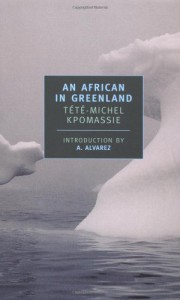An African in Greenland by Tete-Michel Kpomassie

This is the travelogue of a young man from Togo who determined at age 16 that he would go to Greenland, then spent the next 8 years working his way there. A quarter of the way through the book, he arrives, and spends the next 15 months traveling gradually further and further north, living with the Inuit, learning their methods of hunting and fishing, and adopting their way of life. His time in Greenland apparently took place in 1965-66, and the culture he found certainly bore the stamp of Danish colonial rulers (well-insulated turf dwellings almost entirely replaced with inferior wooden houses; people living in southern cities had largely given up hunting and depended on government handouts), but in many other ways it still seems quite unique. Families sleeping all together in a single bed with their children and visitors; hunting in kayaks and with dog sleds; packs of huskies that sometimes serve as food themselves when provisions are tight, but which also sometimes attack and eat humans; constant visiting from one home to another, with people wandering right into each other’s houses; butchering animals indoors and eating the meat raw, the children all winding up with blood in their hair; a complete lack of sexual jealousy or concern for fidelity, including in some places ritual “swinging”; it’s a colorful picture Kpomassie paints here. I couldn’t help wondering if his depictions of both Togo and Greenland were deliberately “exotic” to appeal to a European readership with little knowledge of other lands, though a quick online search turned up no evidence of this book having been debunked so far.
That said, it’s definitely an interesting account, allowing readers to armchair-travel to a far-flung place with a unique character. For all Kpomassie seems to love Greenland, it’s a warts-and-all depiction that probably won’t inspire many to follow his footsteps in person; this book isn’t for the squeamish, whether it’s describing the butchering and eating of raw meat, or canine and human bodily functions and sexual behavior. But it is well-written, closely-observed and engaging.
My biggest criticism is that the author’s inner life is oddly lacking, which contributes to the comparison to a fairy tale: there’s little sense of how Kpomassie thinks or feels about much of anything, especially after arriving in Greenland. He writes about his journey as if it were easy: working his way through West Africa and Europe, everywhere he goes he finds a job that allows him to support himself and save money, learns the language easily, finds people willing to take him in where he needs them, and generally gives the impression of being untouched by circumstance, of nothing truly bad ever happening. Perhaps I’m just too used to reading books about dire circumstances myself. But I couldn’t help wondering about the deeper story of his journey and what he did with his life afterwards.
I also have to comment on the bizarrely worthless introduction. The mysterious “A. Alvarez” is an awfully careless reader: stating multiple times, for instance, that Kpomassie spends an entire winter with his final host family, while he tells us quite specifically that he stayed there from July 3 until around September 22, when he took the last boat out before the pack ice set in. Alvarez also seems to seriously misread the python cult episode in Togo, claiming that the head priestess demanded Kpomassie as a devotee in exchange for healing, while actually, his father paid for the healing separately, and the request that he also become a priest was based on his personal qualities and considered an honor by his family. Why the publisher would even include this careless waste of ink in the book is beyond me.
Overall, an interesting and unusual book, and one I generally enjoyed while reading it, though I wasn’t always drawn to pick it up. Certainly worth a read for the armchair traveler.





